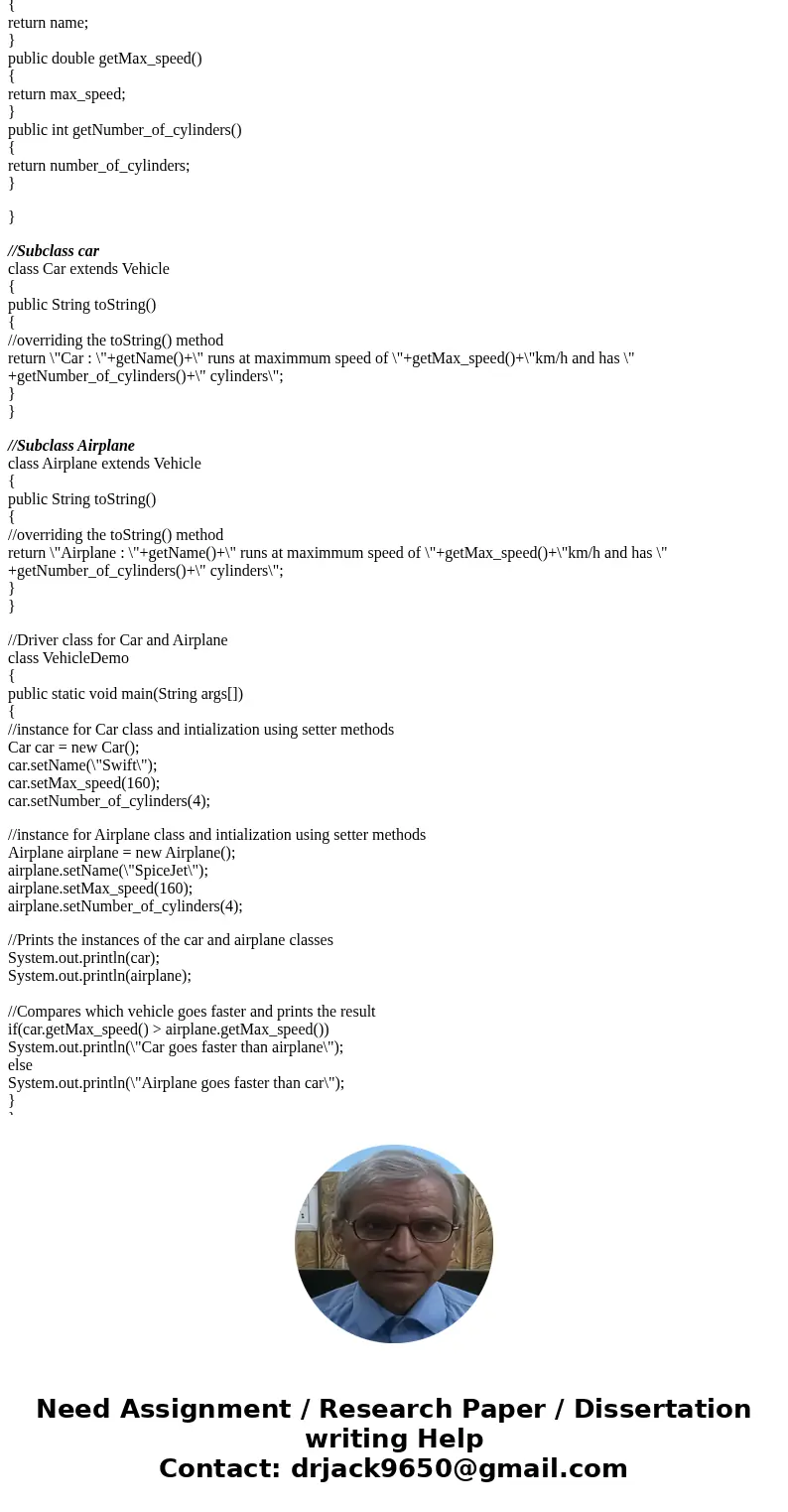Use inheritance to implement the following classes A A Car t
Use inheritance to implement the following classes: A: A Car that is a Vehicle and has a name, a max_speed value and an instance variable called the number_of_cylinders in its engine. Add public methods to set and get the values of these variables. When a car is printed (using the toString method), its name, max_speed and number_of_cylinders are shown. B: An Airplane that is also a vehicle and has a name, a max_speed value and an instance variable called the number_of_engines it has. Add public methods to set and get the values of these variables. When an airplane is printed (using the toString method), its name, max_speed and number_of_engines are shown. C: Write a VehicleDemo.java class that does the following: 1- Creates an instance of a Car and an Airplane class. 2- Assign values to the name, speed, number_of_cylinders (for the Car object) and number_of_engines (for the Airplane object) variables. 3- Compares which vehicle goes faster and prints the result. 4- Prints the instances of the car and airplane classes. Add the following changes to the above problem: A: Make the Vehicle an abstract class and add the following abstract method to it: double runningCost(int hour); Which receives the hours of operation as a parameter and returns the running cost of the vehicle. The Car and Airplane classes will implement this method as follows: 1- For the Car class, define a private double constant called COST_PER_CYLINDER_PER_HOUR = 10.5. The runningCost of a Car will be equal to: hours * COST_PER_CYLINDER_PER_HOUR * number_of_cylinders 2- For the Airplane class, define a private double constant called COST_PER_ENGINE_PER_HOUR = 25.3. The runningCost of an Airplane will be equal to: hours * COST_PER_ ENGINE _PER_HOUR * number_of_engines B: Write an interface called maintainable, which has the following method: double maintenanceCost(double costPerUnit); It receives the cost per unit of an engine or cylinder and returns the maintenance cost. The Car and Airplane classes will implement this interface as follows: 1- For the Car class, the maintenance cost of a Car will be equal to: costPerUnit * number_of_cylinders 2- For the Airplane class, the maintenance cost of an Airplane will be equal to: costPerUnit * number_of_engines C: Add a String toString() method to the Vehicle class. When a Vehicle is printed, its name and max_speed are shown. Also, the String toString() methods of the Car and Airplane classes will show the following: 1- When a car is printed, its name, max_speed, number_of_cylinders and COST_PER_CYLINDER_PER_HOUR are shown. 2- When an airplane is printed, its name, max_speed, number_of_engines and COST_PER_ ENGINE _PER_HOUR are shown. D: Write a VehicleDemo.java class that does the following: 1- Creates an instance of a Car and an instance of an Airplane class. 2- Assigns values to the name, max_speed and number_of_cylinders instance variables of the Car object and the name, max_speed and number_of_engines instance variables of the Airplane object. 3- Calls all the methods of the Car and Airplane objects that return the values of their instance variables and prints the results. 4- Calls the runningCost(5) of the Car and Airplane objects and prints the result. 5- Calls the maintenanceCost (30.0) of the Car and maintenanceCost (250.0) of the Airplane objects and prints the result. 6- Defines a reference variable of type Vehicle and assigns it to an instance of a Car class. Example: Vehicle v1 = new Car(…); 7- Prints v1. Notice whether the toString() method of the Vehicle class is called or the toString() method of the Car class. Explain why it has been the case. In Object Oriented paradigm, what is this called? I need java coding for both questions
Solution
//Base class Vehicle
class Vehicle
{
String name;
double max_speed;
int number_of_cylinders;
//Setter methods
public void setName(String t_name)
{
name = t_name;
}
public void setMax_speed(double t_max_speed)
{
max_speed = t_max_speed;
}
public void setNumber_of_cylinders(int t_number_of_cylinders)
{
number_of_cylinders = t_number_of_cylinders;
}
//Getter methods
public String getName()
{
return name;
}
public double getMax_speed()
{
return max_speed;
}
public int getNumber_of_cylinders()
{
return number_of_cylinders;
}
}
//Subclass car
class Car extends Vehicle
{
public String toString()
{
//overriding the toString() method
return \"Car : \"+getName()+\" runs at maximmum speed of \"+getMax_speed()+\"km/h and has \" +getNumber_of_cylinders()+\" cylinders\";
}
}
//Subclass Airplane
class Airplane extends Vehicle
{
public String toString()
{
//overriding the toString() method
return \"Airplane : \"+getName()+\" runs at maximmum speed of \"+getMax_speed()+\"km/h and has \" +getNumber_of_cylinders()+\" cylinders\";
}
}
//Driver class for Car and Airplane
class VehicleDemo
{
public static void main(String args[])
{
//instance for Car class and intialization using setter methods
Car car = new Car();
car.setName(\"Swift\");
car.setMax_speed(160);
car.setNumber_of_cylinders(4);
//instance for Airplane class and intialization using setter methods
Airplane airplane = new Airplane();
airplane.setName(\"SpiceJet\");
airplane.setMax_speed(160);
airplane.setNumber_of_cylinders(4);
//Prints the instances of the car and airplane classes
System.out.println(car);
System.out.println(airplane);
//Compares which vehicle goes faster and prints the result
if(car.getMax_speed() > airplane.getMax_speed())
System.out.println(\"Car goes faster than airplane\");
else
System.out.println(\"Airplane goes faster than car\");
}
}
Sample Testing:
Car : Swift runs at maximmum speed of 160.0km/h and has 4 cylinders
Airplane : SpiceJet runs at maximmum speed of 160.0km/h and has 4 cylinders
Airplane goes faster than car



 Homework Sourse
Homework Sourse